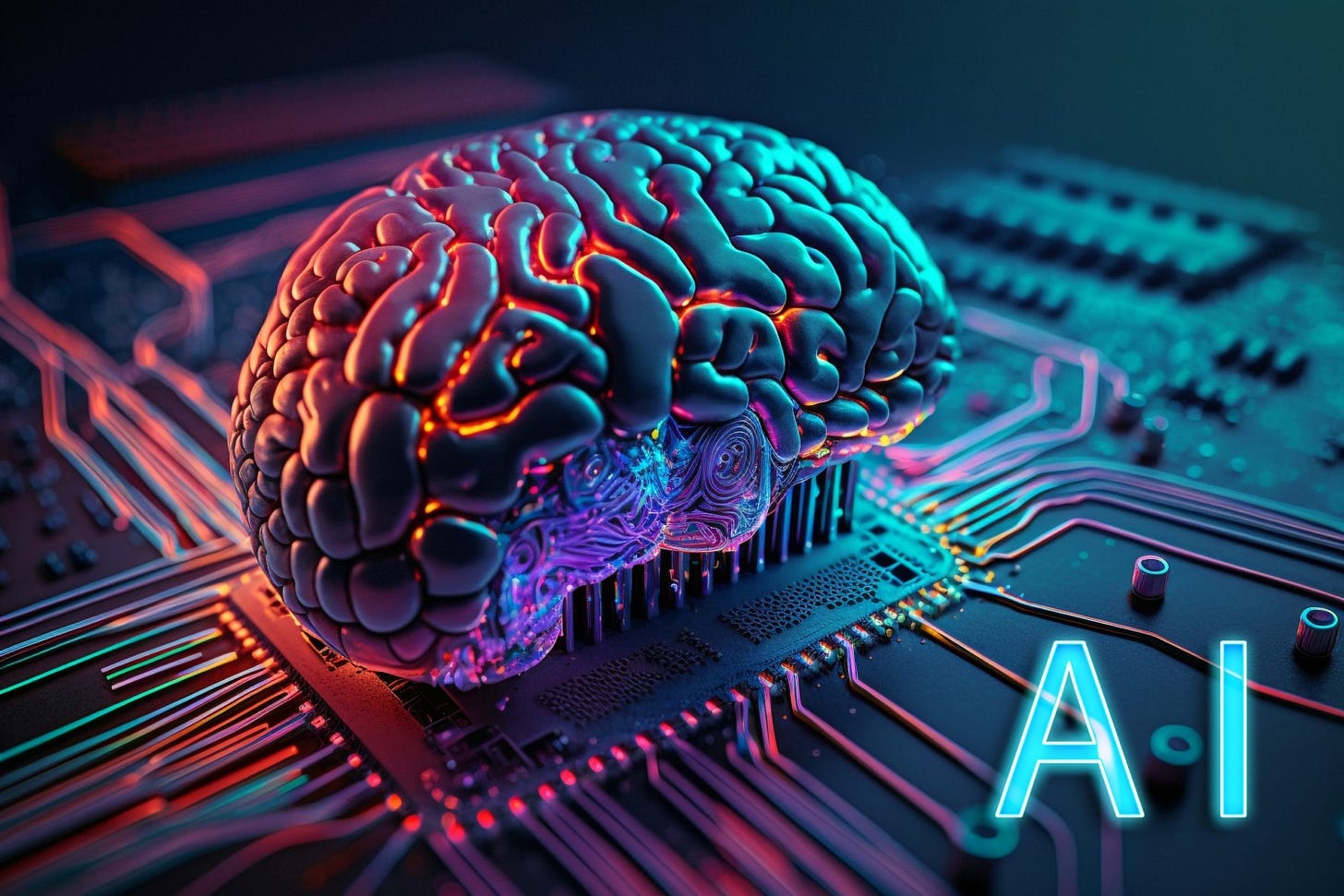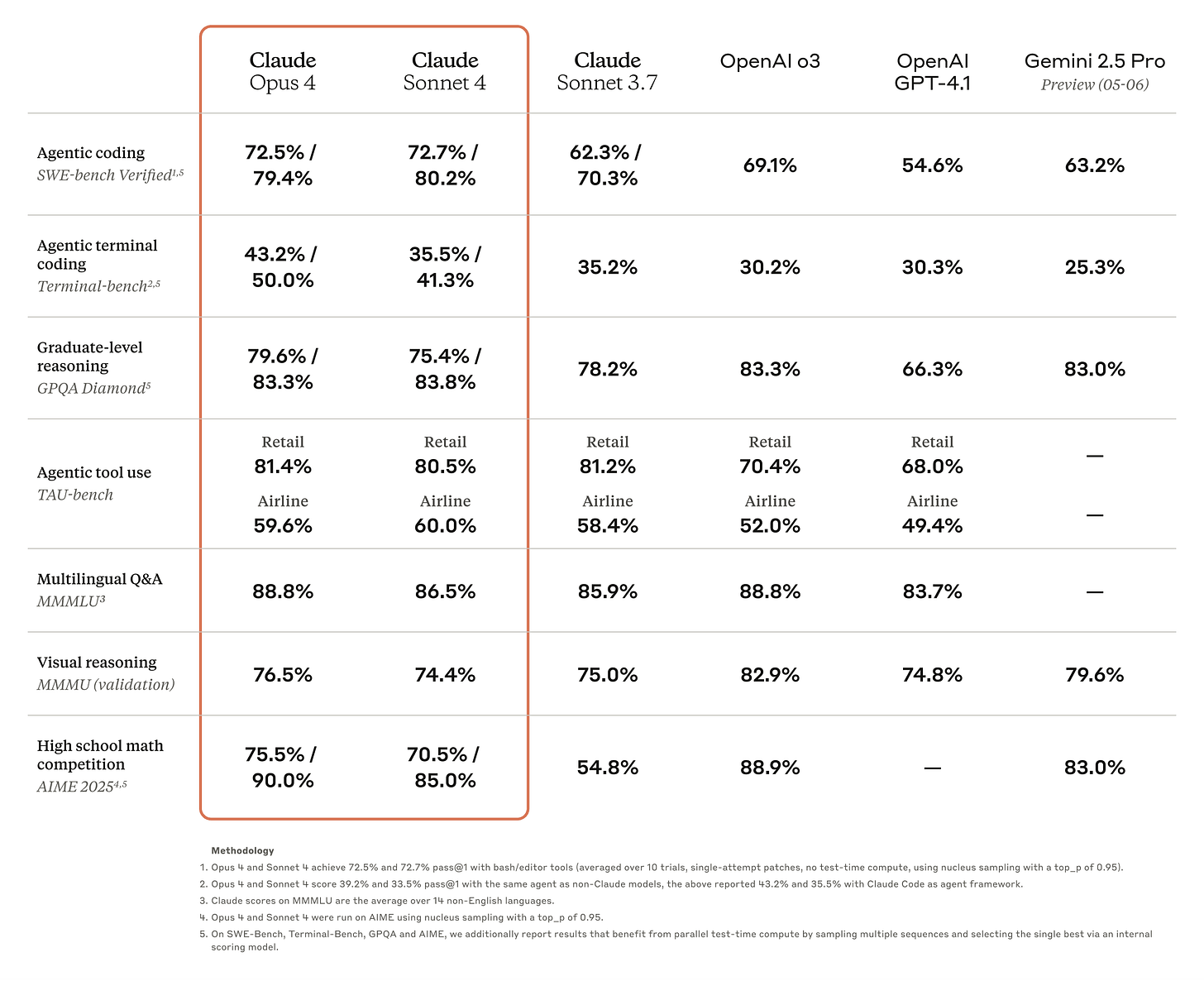Don’t miss an edition, hit this ☝️☝️subscribe button☝️☝️ right up here. And catch up on every edition that passed you by in our archives.
In This Week’s Round-Up:
We’re going to skip crypto art news (wasn’t really anything anyways) 😪…
…So that we can catch ourselves up on maybe the most populated week in AI ever
And take a crash course on Stablecoin Regulation
Okay, Let’s Get On With It
The Tech Side
Simply put, I’m not sure I’ve ever seen such a glut of AI developments all teased, revealed, or released in a single week. The heavens have opened-up, and down upon us pours the future. It feels like the paradigm for AI capability has entirely shifted in the last few days, in ways overt and subtle, and so this week, in lieu of diving deep in one topic, I wanted to keep us all abreast of the multiple wildly important AI developments that may have flown by unseen. Let’s start here:
Iphone Designer, Jony Ive, joins OpenAI to Create a Dedicated ChatGPT Device
On Wednesday, OpenAI and Sam Altman released a fairly weird nine-minute video, highly-produced and incredibly well-shot, that centered around a conversation between Mr. Altman —who we all know as CEO of OpenAI— and Mr. Jony Ive, former Chief Design Officer of Apple and the man who helped shape almost all of Apple’s products from the late 90’s onward, including the iMac, the iPhone, the iPod. It’s kind of stunning to really think about how oft-imitated Apple’s product designs have been, and thus how vital Ive’s vision has been to how we collectively conceptualize technology. In the video, Ive details how his hardware design studio, Io (pronounced aye-oh), is merging with OpenAI to begin work on what they call “a family of devices that would let people use AI to create all sorts of wonderful things,” in Altman’s words.
“I think it is the coolest piece of technology the world will have ever seen,” Altman continues, discussing a prototype of Io/OpenAI’s dedicated device. His comment obviously has much marketing spirit imbued into it, but Altman continues by denigrating the current experience of using AI on a laptop or phone, concluding that “this technology deserves something much better.” Specifically, he says that the experience of web-based AI is inferior because “I’d have to explain that thing [I wanted to know]” to a ChatGPT browser window, which certainly sounds a lot like Why shouldn’t AI know what I’m going to ask in advance? At the very least, his words suggest a device that intrinsically recognizes, or anticipates, one’s queries. Immediately, I find myself thinking of “Samantha,” the AI at the center of Spike Jonze’s 2013 film, Her, which resides in an always-on earpiece that both listens and responds to the world around it. Also something like the 1999 Disney Channel film, Smart House (very influential for some of us), where a home-AI system adopts a personality and begins interjecting personally in the day-to-day lives of its inhabitants.
There isn’t any more grounded information presented about what these products look like or how AI is being presented within them, but given that OpenAI bought Ive’s io for $6.5-billion, the AI giant is obviously betting that AI-centric hardware will prove a differentiator for themselves in what is becoming an increasingly cluttered market for chatbot-esque AI interfaces (between OpenAI, Google, Deepseek, Meta, Manus, Anthropic, etc.)
Claude 4.0 Models Release
While most LLM creators boast about the coding capabilities of their models, Anthropic’s recently-released Claude 4 models are marketed almost entirely around their specific capacity to perform more and more complex coding tasks. Given that, and given what you probably know about me if you read this newsletter with any frequency, I have no ability to tell what makes one model better at coding than another, so whatever I say here about Claude Opus 4 and Claude Sonnet 4 —the former of which Anthropic claims to be “the world’s best coding model”— will be heavily-drawn from their own marketing materials and what I’m seeing in the ether. Regardless, whenever one of the big AI companies releases a new model with an integer attached to it, it bears our attention, whether we understand its proclaimed superiority or not.
Most of the new features available in the two models, Opus 4 and Sonnet 4 (the former being tailored for complex coding tasks and the latter being optimized for day-to-day business tasks) are discussed in the video Anthropic released for the announcement:
Now, I feel like there are always graphs like this released with every new model, so take this one with a grain of salt, but it’s still pretty wild to see how quickly these AI models are bounding over the accomplishments of their previous generations:
I’ll need to wait a while to hear anecdotal evidence regarding the successes or failures of these models (and, to be fair, I don’t know a ton of Claude users), so please, if you’re playing around with it, tell your ol’ pal Max what you think.
Google Veo3 Revolutionizes AI Video
Maybe I’m burying the lede on this entire section because the most impressive single AI development from this onslaught of a week was the new video generation software from Google, Veo3. This shit is just insane, the realism and complexity of these videos, far above and beyond —in composition, in realistic voice and character, in shot complexity, in naturalness— any kind of AI-generated video I’ve seen before. Veo3 is also the first model to generate synchronized video and audio, which is a veritable sea-change in how artists use these models, making what was once complex work trivial (and immediate). In lieu of discussing Veo3 further on any technical level, I’ll just give you some examples of videos generated with it and watch your mind melt at how nearly indistinguishable they are from human-created content. Chat, we might be cooked.
This unbelievable video comes from MindWank, generated in 3 days.
This one is from Jerrod Lew and showcases Veo3’s insane video/audio synchronization.
Here’s one from László Gaál which is just bizarre.
But my favorite (and sure to be yours too) is this from MetaPuppet:
A few notes:
All of these videos are edited together from many individually-generated clips, where that’s not obvious. I’m not sure if the editing software is also AI-based.
As per Webb Wright at zdnet, Veo3, is “available now for Gemini Ultra subscribers in the US. It can also be accessed through Flow, Google's new AI-powered filmmaking tool, which was also unveiled at I/O this week.” So if you have your hands on it, I’d love to see what you’re working on.
We really might be so cooked.
Some Other Cool Shit from Google I/O
If you want to know about literally everything that Google announced at their annual developer’s conference, I/O (Veo3 included), you can read their internal blog featuring some 100 announcements, but I want to highlight a few others:
Mashable, in their own round-up of I/O news, begins with a new AI mode for Google Search —think an expanded, more intricate internal mechanism for using AI to answer even complex Google queries— but they mostly gloss over that a “Personal Context” mode will be coming to AI Mode. Personal Context mode will suggest answers (probably not too far off from just making an entire algorithmic time-suck browser window) using not just past searches but all the information in your Gmail and Google Drive accounts. Man, that could be dangerous. It’ll also make Google products that much harder to step away from; it’s already impossible for me to leave Chrome and my connected Google accounts, but when their search engine is able to predict my questions and fine-tailor responses to my history, there might be no swimmer alive strong enough to out-paddle that whirlpool. And I bet that of all the things Google announced (maybe even all the things we discuss today), it’ll be the most penetrative.
And then there are a few advancements in AI-assisted shopping experiences that are sure to become industry standard. My buddy Jake was particularly smitten with a feature that uses AI-assisted AR-mapping to affix clothing you see in-browser onto photos of yourself, which is bonkers. Literally “What would I look like in that,” and bang, Google will show you, the clothes tailored to your form. You’ll also be able to search for clothing or furniture or honestly whatever you want with nothing more than a prompt, and various options for purchasing it will automatically populate.
Finally, I want to highlight Gemini Ultra, which packages together Gemini 2.5 Pro (Google’s latest Gemini model, capable of something akin to ChatGPT’s DeepResearch called DeepThink) with applications like Veo3 and Flow (video-editing software). I wonder how prolific these “AI bundles” will become, like Cable in the old days, where every bundle basically does the same thing, offers the same suite of tools, but everyone will have one.
I’m linking some other breakdowns of I/O’s offerings that provide more detail, from TechCrunch, Mashable (as mentioned above), and TechRadar, so that you can dig deeper than I did, if you so choose.
The Finance Side
I’ve been meaning to write this column for a while, a kind of entry-level breakdown about what the hell Stablecoins actually are, not at a low-level —I think we all intrinsically understand the personal need for coins whose value is pegged to some kind of outside asset like the dollar— but at an institutional one. For weeks, the Genius Act has been floating around the United States Senate, this a bill that promises to “provide regulatory clarity to this important industry, keep innovation on shore, add robust consumer protection, and reaffirm the dominance of the U.S. dollar,” according to Senator Kirsten Gillibrand. If you’re a sicko, you can read the bill in its entirety, or opt for this less-intense breakdown from the Senate Committee on Banking, Housing, and Urban Affairs (although it is much more partisan). The notable goals of the bill are as follow :
In essence, the U.S. Government seemingly wants to keep issuers and large-holders of Stablecoins from being able to game the system or harm consumers using their massive sway. The Genius Act is also the closest a crypto-related bill has ever come to being actively signed into law, given it was, on Monday, moved through the Senate 66 to 32, a hurdle that, now overcome, seems to fate the bill for passage by the Senate, House, and ultimately the President. But I want both of us understand more about why Stablecoins are such an interesting prospect for huge banking institutions, and thus why regulatory frameworks are necessary for them in the first place.
According to SCMP, “An increasing number of businesses around the world are using stablecoins for cross-border payments and remittances, particularly in emerging markets with large underbanked populations,” while also highlighting that Stablecoins are attractive to crypto-integrated banks because it allows them to keep their holdings in crypto without needing to convert back and forth to Fiat. Makes sense so far.
But the reason for this increasing use lies in the immediacy of their transaction speeds, or their relative immediacy compared to Fiat. In the case of traditional bank transfers, usually referred to as SWIFT transfers, 2-5 days may pass before paid funds are recorded in the great ledger in the sky and deposited into a recipient’s accounts. If I buy a traditional stock on a platform like Schwab, my control of that stock’s value —which I’ve just paid for— is conditional on whether my payment actually goes through to the holding corporation, unknowable for multiple days. I essentially own that stock on credit. This is the case for nearly every moving financial part. It’s why checks take a few days to cash. It’s why high-frequency trading desks set-up as close as possible to the actual stock markets, to cut down on wait times for transaction processings. It’s why I have to wait 3 business days before my Venmo cash-outs appear in my account (unless I want to pay a fee). There exists in perpetual motion a massive network of accounts receivable, debt piling-up and moving around, unsettled transactions that are inherently destabilizing in nature. The waiting period between a made payment and the establishment of that payment in an account is called “float,” and it’s another tool in the institutional banking system’s arsenal.
Floating funds can still be used by banks to generate income, invest in high-frequency trades, bundle and send elsewhere, etc. The wickedly-complicated ledger of institutional banking transactions is often a result of float, all this money existing in the ether, somehow in two places at once for a period of time, almost always at the institution’s advantage. Much regulation has been established to keep banks from over-risking floated funds, but regulation depends on state actors, so Swiss banks (famously unregulated), for example, may be able to benefit from float in a way that more regulated banking partners abroad cannot.
The beauty of Stablecoin transactions, meanwhile, is their instantaneousness. There is no float, at least not more than a few minutes if transacting on Ethereum, and on other chains, the wait times for transaction validation is near instant. This is a boon for smaller banks that may be on the disadvantageous end of float when transacting with larger banks, bringing equality (we hope) to banks with different levels of governmental regulations. The Genius Act —to my understanding— seeks to keep big banks from finding their own profitable loopholes in the Stablecoin system, including an oft-communicated fear wherein massive banks gang-up on small banks and FinTech firms by establishing their own Stablecoins to benefit from.
I don’t know if The Genius Act’s regulations can actually accomplish their loftily-spun aims, but it should be noted that many Democratic voices in the Senate call the Genius Act toothless or otherwise a power-grab by the Trump administration. Senator Mark Warner said:
“Many senators, myself included, have very real concerns about the Trump family’s use of crypto technologies to evade oversight, hide shady financial dealings, and personally profit at the expense of everyday Americans. We have a duty to shine a light on these abuses and stop Donald Trump from exploiting emerging technologies to enrich himself, dodge accountability, and weaken the safeguards that protect American consumers and the rule of law.”
And I know we don’t love Elizabeth Warren generally in the crypto world, but she “insisted, ‘while a strong stablecoin bill is the best possible outcome, this weak bill is worse than no bill at all,’” and I’m inclined to agree. Knowing the general financial preferences of America’s conservative party, I’m dubious this bill would put significant guardrails on banks, and maybe there are no guardrails they could not bound over. Hopefully, this is not an area where our collective education comes in hindsight, only after a long string of abuses. But it’s regulation, and it’s banks, so that’s probably exactly what will happen.
Nevertheless, I’m certainly no policy expert, and don’t have a strong opinion on the efficacy of the Genius Act. Hopefully with a bit more mutual knowledge on the subject, however, we can both follow these proceedings in a more informed light. And maybe a more infuriated —or inspired!— column will be soon to follow should this get signed into law.
DeCC0 of the Week

Art in the Wild
Dev Corner
In Rene’s words: “initialized and pushed the MOCA library UX revamp to v2.museumofcryptoart.com”
In my words, you can go right now to v2.museumofcryptoart.com and take a spin with The Library, our dedicated crypto art LLM and soon-to-be the basis for all our upcoming AI experiments. We’d really love your feedback on The Library (don’t need to sign-up or anything, just come with a question or two), and hope you find it as fundamental a tool as we believe it can be. It can sort-through and reference hundreds of texts from throughout crypto art’s history, with more coming soon.
We’re also working on our collaboration with our newest partners, Comput3, so stay tuned for more news on that front.
Quote of the Week
“Without craftsmanship, inspiration is a mere reed shaken in the wind.”
Do you have some news that simply must be shared? Send us a DM










Thank you so much for this extensive research ❤️